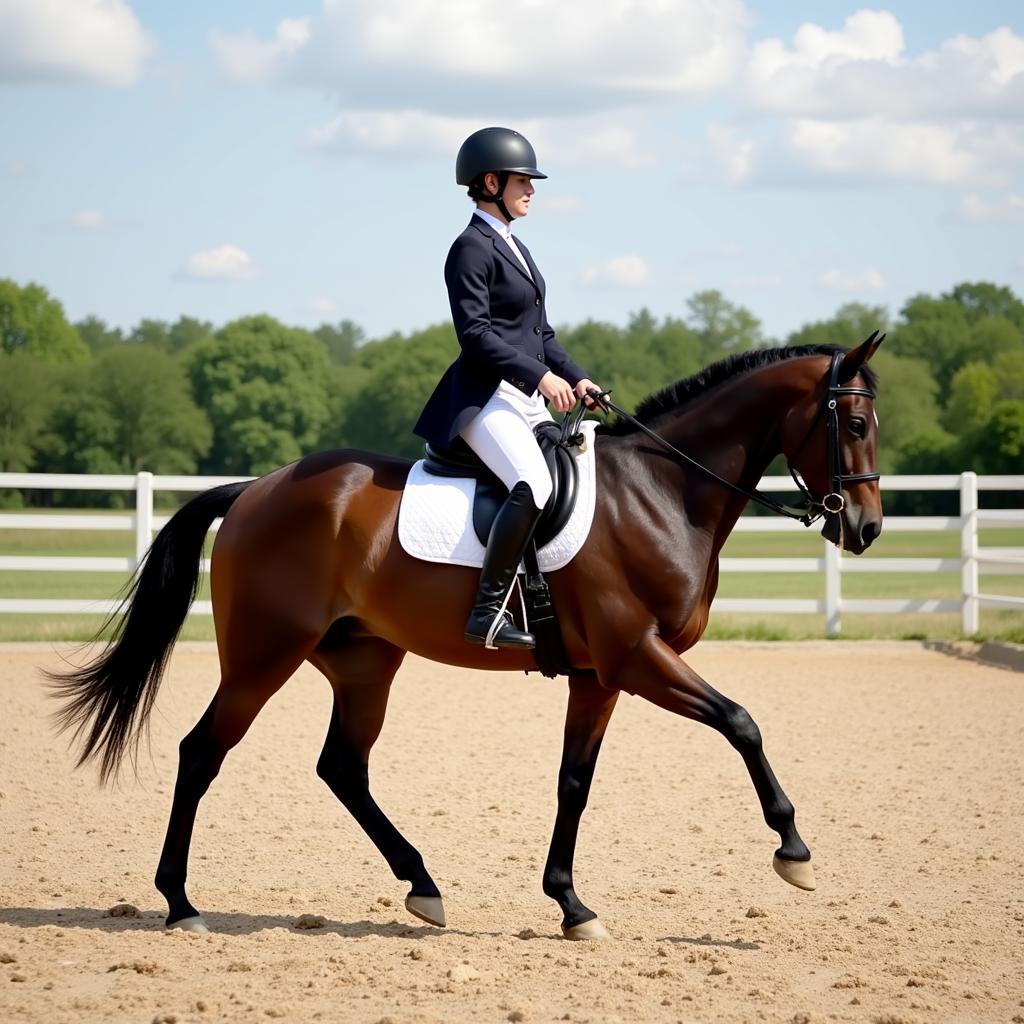Pro stride in horses is a term that often piques the interest of equestrians, particularly those involved in disciplines where gait and performance are paramount. While it might sound like a specific training program or a piece of equipment, “pro stride” actually refers to a horse’s natural ability to cover ground efficiently and with a naturally long stride. This inherent quality is influenced by conformation, breed, and individual genetics.
The Building Blocks of Pro Stride: Conformation is Key
A horse’s conformation, the physical makeup and structure of its body, plays a crucial role in its ability to achieve an impressive pro stride. Several key features contribute to this desirable trait:
- Sloping Shoulder: A horse with a well-sloped shoulder has increased range of motion in its front legs, allowing for a longer reach and a smoother, more ground-covering stride.
- Long Forearm: Coupled with a sloping shoulder, a long forearm further amplifies the horse’s ability to extend its front legs and achieve a naturally extended stride.
- Well-Angled Hindquarters: The power generated from the hindquarters is essential for a powerful pro stride. Horses with well-angled hindquarters can engage their hind legs effectively, propelling themselves forward with greater force and covering more ground with each stride.
Breed Predispositions: Genetics at Play
While conformation plays a significant role, certain breeds are inherently predisposed to possess a naturally longer stride due to generations of selective breeding. Breeds like Warmbloods, Thoroughbreds, and American Saddlebreds are often lauded for their impressive movement and natural ability to cover ground efficiently.
“When evaluating a horse for its pro-stride potential, it’s essential to consider both conformation and breed tendencies. While a horse’s natural conformation provides a strong foundation, breed characteristics offer valuable insights into its genetic predisposition for a naturally long and ground-covering stride.” – Dr. Emily Carter, Equine Veterinarian
The Pro Stride Advantage: From Dressage Arenas to Cross Country Courses
A horse with a naturally long, ground-covering stride has a distinct advantage in numerous disciplines:
- Dressage: A long stride allows for more expressive and ground-covering movements, contributing to higher scores and a more harmonious overall picture.
- Jumping: Horses with a naturally long stride can clear fences more efficiently, expending less energy and making a smoother jump.
- Cross Country: In eventing, a ground-covering stride is essential for navigating challenging terrain and obstacles efficiently.
- Endurance Riding: The ability to cover ground effortlessly is paramount in endurance, allowing the horse to conserve energy and maintain speed over long distances.
 Horse and Rider Demonstrating Pro-Stride
Horse and Rider Demonstrating Pro-Stride
Nurturing Natural Ability: Training and Conditioning
While genetics and conformation lay the foundation for pro stride, proper training and conditioning are essential for maximizing this natural gift.
- Targeted Exercises: Exercises that encourage the horse to lengthen its stride, such as transitions between gaits and hill work, can help develop and strengthen the muscles needed for a more impressive pro stride.
- Rider Influence: A skilled rider can encourage the horse to extend its stride through proper aids and a balanced seat, allowing the horse to move freely and expressively.
Conclusion
Pro stride in horses is a combination of genetics, conformation, and training, resulting in a naturally long and ground-covering stride that offers numerous advantages across disciplines. By understanding the factors that contribute to this desirable trait, riders and trainers can better identify and develop horses with the potential to excel in their chosen fields.
FAQs
1. Can any horse develop a good pro stride with enough training?
While training can enhance a horse’s natural stride, conformation and genetics play a significant role. Horses with inherent predispositions for a long stride will see more significant improvements with training.
2. Is pro stride more important in certain disciplines than others?
Disciplines that prioritize ground-covering movement, such as dressage, jumping, and endurance riding, benefit greatly from a horse with a naturally long stride.
3. How can I tell if a horse has a naturally good pro stride?
Observing the horse’s conformation, particularly the shoulder, forearm, and hindquarters, can provide clues about its stride potential. Watching the horse move at various gaits can also offer insights into its natural stride length and efficiency.
4. Does a horse’s age affect its pro stride?
A horse’s stride may continue to develop as it matures and gains muscle strength, particularly between the ages of 3 and 5.
5. What are some common mistakes riders make that can hinder a horse’s pro stride?
A rider’s balance and use of aids significantly impact a horse’s stride. Common mistakes include interfering with the horse’s head and neck, riding with an unbalanced seat, and failing to provide clear aids.
For more information about horse health and care, visit our website:
Need personalized guidance on finding the perfect horse with a naturally long stride?
Contact Justus Horses USA today! Our team of experts is dedicated to matching you with your ideal equine partner.
Phone: 0772127271
Email: [email protected]
Address: QGM2+WX2, Vị Trung, Vị Thuỷ, Hậu Giang, Việt Nam
We offer 24/7 customer support to answer all your equestrian needs.